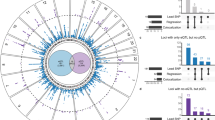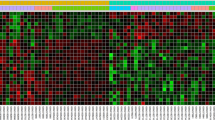Abstract
Atrial fibrillation (AF) is the most common sustained cardiac arrhythmia characterized by extensive structural, contractile and electrophysiological remodeling. The genetic basis of AF remained elusive until now. Transcriptome-wide association study (TWAS) was conducted by FUSION tool using gene expression weights of 7 tissues combined with a large-scale genome-wide association study (GWAS) dataset of AF, totally involving 8180 AF cases and 28,612 controls. Significant genes identified by TWAS were then subjected to gene ontology (GO) and pathway enrichment analysis. The genome-wide mRNA gene expression profiling of AF was compared with the results of TWAS to detect common genes shared by TWAS and mRNA expression profiling of AF. TWAS detected a group of candidate genes with PTWAS values < 0.05 across the seven tissues for AF, such as CMAH (PTWAS = 3.15 × 10–25 for whole blood), INCENP (PTWAS = 1.77 × 10–22 for artery aorta), CMAHP (PTWAS = 4.57 × 10–20 for artery aorta). Pathway enrichment analysis identified multiple candidate pathways, such as protein K48-linked ubiquitination (P value = 0.0124), positive regulation of leukocyte chemotaxis (P value = 0.0046) and fatty acid degradation (P value = 0.0295). Further comparing the GO results of TWAS and mRNA expression profiling, 2 common GO terms were identified, including actin binding (PTWAS = 0.0446, PmRNA = 7.00 × 10–4) and extracellular matrix (PTWAS = 0.0037, PmRNA = 3.00 × 10–6). We detected multiple novel candidate genes, GO terms and pathways for AF, providing novel clues for understanding the genetic mechanism of AF.
Similar content being viewed by others
References
Schotten U, Duytschaever M, Ausma J, Eijsbouts S, Neuberger HR, Allessie M (2003) Electrical and contractile remodeling during the first days of atrial fibrillation go hand in hand. Circulation 107:1433
Chugh SS, Havmoeller R, Narayanan K, Singh D, Rienstra M, Benjamin EJ, Gillum RF, Kim YH, McAnulty JH Jr, Zheng ZJ, Forouzanfar MH, Naghavi M, Mensah GA, Ezzati M, Murray CJ (2014) Worldwide epidemiology of atrial fibrillation: a global burden of disease 2010 study. Circulation 129:837
Fox CS, Parise H, D'Agostino RB Sr, Lloyd-Jones DM, Vasan RS, Wang TJ, Levy D, Wolf PA, Benjamin EJ (2004) Parental atrial fibrillation as a risk factor for atrial fibrillation in offspring. JAMA 291:2851–2855
Arnar DO, Thorvaldsson S, Manolio TA, Thorgeirsson G, Kristjansson K, Hakonarson H, Stefansson K (2006) Familial aggregation of atrial fibrillation in Iceland. Eur Heart J 27:708
Gudbjartsson DF, Hilma H, Solveig G, Gudmar T, Walters GB, Gudmundur T, Jeffrey G, Mathiesen EB, Inger NL, Audhild N (2009) A sequence variant in ZFHX3 on 16q22 associates with atrial fibrillation and ischemic stroke. Nat Genet 41:876
Ellinor PT, Lunetta KL, Glazer NL, Pfeufer A, Alonso A, Chung MK, Sinner MF, de Bakker PI, Mueller M, Lubitz SA (2010) Common variants in KCNN3 are associated with lone atrial fibrillation. Nat Genet 42:240–244
Degner JF, Pai AA, Piqueregi R, Veyrieras JB, Gaffney DJ, Pickrell JK, Leon SD, Michelini K, Lewellen N, Crawford GE (2012) DNase[thinsp]I sensitivity QTLs are a major determinant of human expression variation. Nature 482:390–394
Trynka G, Sandor C, Han B, Xu H, Stranger BE, Liu XS, Raychaudhuri S (2013) Chromatin marks identify critical cell types for fine mapping complex trait variants. Nat Genet 45:124–130
Zhang L, Liu YZ, Zeng Y, Zhu W, Zhao YC, Zhang JG, Zhu JQ, He H, Shen H, Tian Q (2016) Network-based proteomic analysis for postmenopausal osteoporosis in Caucasian females. Proteomics 16:12–28
Gusev A, Ko A, Shi H, Bhatia G, Chung W, Penninx BW, Jansen R, De Geus EJ, Boomsma DI, Wright FA (2016) Integrative approaches for large-scale transcriptome-wide association studies. Nat Genet 48:245
Low SK, Takahashi A, Ebana Y, Ozaki K, Christophersen IE, Ellinor PT, Consortium A, Ogishima S, Yamamoto M, Satoh M (2017) Identification of six new genetic loci associated with atrial fibrillation in the Japanese population. Nat Genet 49:953–958
Lamirault G, Gaborit N, Le Meur N, Chevalier C, Lande G, Demolombe S, Escande D, Nattel S, Léger JJ, Steenman M (2006) Gene expression profile associated with chronic atrial fibrillation and underlying valvular heart disease in man. J Mol Cell Cardiol 40:173–184
Dennis G Jr, Sherman BT, Hosack DA, Yang J, Gao W, Lane HC, Lempicki RA (2003) DAVID: database for annotation, visualization, and integrated discovery. Genome Biol 4:P3
Li J, Solus J, Chen Q, Rho YH, Milne G, Stein CM, Darbar D (2010) Role of inflammation and oxidative stress in atrial fibrillation. Heart Rhythm 7:438–444
Rudolph V, Andrie RP, Rrudolph TK, Friedrichs K, Klinke A, Hirsch HB, Schwoerer AP, Lau D, Fu X, Klingel K, Sydow K (2010) Myeloperoxidase acts as a profibrotic mediator of atrial fibrillation. Nat Med 16:470–474
Fontes ML, Mathew JP, Rinder HM, Daniel Z, Smith BR, Rinder CS (2005) Atrial fibrillation after cardiac surgery/cardiopulmonary bypass is associated with monocyte activation. Anesth Analg 101:17
Aimé-Sempé C, Folliguet T, Rücker-Martin C, Krajewska M, Krajewska S, Heimburger M, Aubier M, Mercadier JJ, Reed JC, Hatem SN (1999) Myocardial cell death in fibrillating and dilated human right atria. J Am Coll Cardiol 34:1577–1586
Frustaci A, Chimenti C, Bellocci F, Morgante E, Russo MA, Maseri A (1997) Histological substrate of atrial biopsies in patients with lone atrial fibrillation. Circulation 96:1180–1184
Zürner M, Schoch S (2009) The mouse and human liprin-α family of scaffolding proteins: genomic organization, expression profiling and regulation by alternative splicing. Genomics 93:243–253
Claudia A, Veronica A, Antonio T, Simona P, Ivan DC (2009) Liprin-alpha1 promotes cell spreading on the extracellular matrix by affecting the distribution of activated integrins. J Cell Sci 122:3225
Miguel SM, Gregus KA, Nichol RH, O'Toole SM, Gomez TM (2015) Regulation of ECM degradation and axon guidance by growth cone invadosomes. Development 142:486–496
Kirby ML, Stewart DE (1983) Neural crest origin of cardiac ganglion cells in the chick embryo: identification and extirpation. Dev Biol 97:433–443
Owais K, Bartz TM, Ix JH, Heckbert SR, Kizer JR, Zieman SJ, Mukamal KJ, Tracy RP, Siscovick DS, Luc D (2012) Plasma free fatty acids and risk of atrial fibrillation (from the cardiovascular health study). Am J Cardiol 110:212–216
Khawaja O, Bartz TM, Ix JH, Heckbert SR, Kizer JR, Zieman SJ, Mukamal KJ, Tracy RP, Siscovick DS, Djouss L (2012) Plasma free fatty acids and risk of atrial fibrillation (from the cardiovascular health study). American Journal of Cardiology 110:212–216
Paolisso G, Gualdiero P, Manzella D, Rizzo MR, Tagliamonte MR, Gambardella A, Verza M, Gentile S, Varricchio M, D'Onofrio F (1997) Association of fasting plasma free fatty acid concentration and frequency of ventricular premature complexes in nonischemic non-insulin-dependent diabetic patients. Am J Cardiol 80:932–937
Soloff LA (1970) Arrhythmias following infusions of fatty acids. Am Heart J 80:671–674
Kurien VA, Oliver MF (1970) A metabolic cause for arrhythmias during acute myocardial hypoxia. Lancet 295:813–815
Kelly RA, O'Hara DS (1985) Characterization of digitalis-like factors in human plasma. Interactions with NaK-ATPase and cross-reactivity with cardiac glycoside-specific antibodies. J Biol Chem 260:11396
Lin Q, Jia L, Sun Y (2012) A pilot study of circulating PPAR-γ receptor protein in elderly patients with atrial fibrillation. Arch Med Sci AMS 8:471–476
Xiaoping C, Ziyi B, Jiyun H, Lingyun J, Xiaojia L, Yanling S, Bing K, Dejia H, Yuquan W (2010) Downregulation of peroxisome proliferator-activated receptor-gamma expression in hypertensive atrial fibrillation. Clin Cardiol 32:337–345
Inden Y, Kitamura K, Uchikawa T, Harata S (2008) Pioglitazone, a peroxisome proliferator-activated receptor-gamma activator, attenuates atrial fibrosis and atrial fibrillation promotion in rabbits with congestive heart failure. Heart Rhythm Off J Heart Rhythm Soc 5:451–459
Gu J, Liu X, Wang X, Shi H, Tan H, Zhou L, Gu J, Jiang W, Wang Y (2011) Beneficial effect of pioglitazone on the outcome of catheter ablation in patients with paroxysmal atrial fibrillation and type 2 diabetes mellitus. Europace 13:1256–1261
Lappalainen T, Sammeth M, Friedländer MR, 't Hoen PA, Monlong J, Rivas MA, Gonzàlez-Porta M, Kurbatova N, Griebel T, Ferreira PG, Barann M, Wieland T, Greger L, van Iterson M, Almlöf J, Ribeca P, Pulyakhina I, Esser D, Giger T, Tikhonov A, Sultan M, Bertier G, MacArthur DG, Lek M, Lizano E, Buermans HP, Padioleau I, Schwarzmayr T, Karlberg O, Ongen H, Kilpinen H, Beltran S, Gut M, Kahlem K, Amstislavskiy V, Stegle O, Pirinen M, Montgomery SB, Donnelly P, McCarthy MI, Flicek P, Strom TM, Lehrach H, Schreiber S, Sudbrak R, Carracedo A, Antonarakis SE, Häsler R, Syvänen AC, van Ommen GJ, Brazma A, Meitinger T, Rosenstiel P, Guigó R, Gut IG, Estivill X, Dermitzakis ET, Geuvadis Consortium (2013) Transcriptome and genome sequencing uncovers functional variation in humans. Nature 501(7468):506–511
Xiaoling Z, Roby J, Chen BH, Tianxiao H, Saixia Y, Munson PJ, Johnson AD, Daniel L, O'Donnell CJ (2015) Identification of common genetic variants controlling transcript isoform variation in human whole blood. Nat Genet 47:345–352
Raj T, Rothamel K, Mostafavi S, Ye C, Lee MN, Replogle JM, Feng T, Lee M, Asinovski N, Frohlich I (2014) Polarization of the effects of autoimmune and neurodegenerative risk alleles in leukocytes. Science 344:519–523
Acknowledgements
This work was supported by the National Natural Scientific Foundation of China (81472925, 81673112); the Key projects of international cooperation among governments in scientific and technological innovation (2016YFE0119100); the Natural Science Basic Research Plan in Shaanxi Province of China (2017JZ024);Program for Tackling Key Problems in Shannxi Provincial Science and Technology (2016SF-288); and the Fundamental Research Funds for the Central Universities.
Author information
Authors and Affiliations
Contributions
LZ and LL drafted the manuscript, FZ designed the study. MM, SC, YZ, HH, XL and PL performed the statistical analyses. YW, BC, CL, MD, QX and YD provided feasible advice on data analysis and drafting manuscript. All authors read and approved the final manuscript. All authors discussed the results and commented on the manuscript.
Corresponding author
Ethics declarations
Conflict of interest
The authors declare no conflict of interest.
Additional information
Publisher's Note
Springer Nature remains neutral with regard to jurisdictional claims in published maps and institutional affiliations.
Electronic supplementary material
Below is the link to the electronic supplementary material.
Rights and permissions
About this article
Cite this article
Zhang, L., Liu, L., Ma, M. et al. Integrative analysis of transcriptome-wide association study data and mRNA expression profiles identified candidate genes and pathways associated with atrial fibrillation. Heart Vessels 34, 1882–1888 (2019). https://doi.org/10.1007/s00380-019-01418-w
Received:
Accepted:
Published:
Issue Date:
DOI: https://doi.org/10.1007/s00380-019-01418-w




